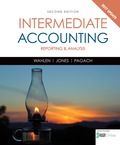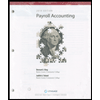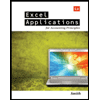
1.
Prepare the
1.
Explanation of Solution
Vacation Pay Liability:
Vacation pay is a benefit paid by the employers for the full-time employees that allows the employees to take the salaried vacation.
Prepare the journal entry to record the liability of sick pay and vacation pay for the first quarter.
| Date | Account titles and explanation | Debit ($) | Credit($) |
| March 31, 2016 | Salaries expenses (3) | 9,000 | |
| Liabilities for compensated absences | 9,000 | ||
| (To record the liability of sick pay and vacation pay for the first quarter) |
Table (1)
Working note (1):
Determine the amount of liability for compensated absences – sick leave.
Working note (2):
Determine the amount of liability for compensated absences – Vacation leave.
Working note (3):
Determine the liability for compensated absences.
- Salaries expense is an expense account and it decreases the value of
stockholders’ equity. Thus, debit salaries expense with $9,000. - Liabilities for compensated absences are a liability account and it is increased. Thus credit liabilities for compensated absences with $9,000.
Prepare the journal entry to record the monthly payroll on April 30, 2016.
| Date | Account titles and explanation | Debit ($) | Credit($) |
| April 30, 2016 | Salaries expenses | 42,000 | |
| Liabilities for compensated absences | 3,000 | ||
| Cash | 45,000 | ||
| (To record the payroll expenses paid) |
Table (2)
- Salaries expense is an expense account and it decreases the value of stockholders’ equity. Thus, debit salaries expense with $42,000.
- Liabilities for compensated absences are a liability account and it is decreased. Thus debit liabilities for compensated absences with $9,000.
- Cash is an asset account and it is decreased. Thus, credit cash with $45,000.
Prepare the journal entry to record the liability of sick pay and vacation pay for the second quarter.
| Date | Account titles and explanation | Debit ($) | Credit($) |
| March 31, 2016 | Salaries expenses (6) | 9,000 | |
| Liabilities for compensated absences | 9,000 | ||
| (To record the liability of sick pay and vacation pay for the second quarter) |
Table (3)
Working note (4):
Determine the amount of liability for compensated absences – sick leave.
Working note (5):
Determine the amount of liability for compensated absences – Vacation leave.
Working note (6):
Determine the liability for compensated balances.
- Salaries expense is an expense account and it decreases the value of stockholders’ equity. Thus, debit salaries expense with $9,000.
- Liabilities for compensated absences are a liability account and it is increased. Thus credit liabilities for compensated absences with $9,000.
2.
Prepare a partial interim balance sheet as of June 30, 2016 for disclosing the liabilities that are created.
2.
Explanation of Solution
Balance sheet: This financial statement reports a company’s resources (assets) and claims of creditors (liabilities) and stockholders (stockholders’ equity) over those resources. The resources of the company are assets which include money contributed by stockholders and creditors. Hence, the main elements of the balance sheet are assets, liabilities, and stockholders’ equity.
Prepare the balance sheet:
| Corporation R | |
| Balance sheet (Partial) | |
| As on June 30, 2016 | |
| Liabilities | Amount |
| Current liabilities: | |
| Liability for compensated absences | $15,000 |
Table (4)
3.
Discuss the underlying conceptual basis of accounting for compensated absences.
3.
Explanation of Solution
Compensated absences represent an expense that has been incurred by the employer but not yet paid. Because, the company has the responsibility to the employee for the service rendered, this will be accumulated, payment is probable and this can be reasonably estimated and thus the company must accrue an expense related to compensate absences. Hence, it is a liability of the employer to recognize the expenses related to the compensated absences in the period in which the employees work and earn the benefits.
Want to see more full solutions like this?
Chapter 9 Solutions
EBK INTERMEDIATE ACCOUNTING: REPORTING
- Can you solve this general accounting question with the appropriate accounting analysis techniques?arrow_forwardCan you explain the correct approach to solve this general accounting question?arrow_forwardPlease help me solve this general accounting problem with the correct financial process.arrow_forward
- Please help me solve this general accounting problem with the correct financial process.arrow_forwardAccounting solutionarrow_forwardJoe and Ethan each own 50% of JH Corporation, a calendar year taxpayer. Distributions from JH are: $750,000 to Joe on April 1 and $250,000 to Ethan on May 1. JH’s current E & P is $300,000 and its accumulated E & P is $600,000. How much of the accumulated E & P is allocated to Ethan’s distribution? a. $0b. $75,000c. $150,000d. $300,000e. None of the above b or c?arrow_forward
- Please provide the accurate answer to this general accounting problem using appropriate methods.arrow_forwardI need guidance with this general accounting problem using the right accounting principles.arrow_forwardPlease provide the accurate answer to this general accounting problem using appropriate methods.arrow_forward
 Intermediate Accounting: Reporting And AnalysisAccountingISBN:9781337788281Author:James M. Wahlen, Jefferson P. Jones, Donald PagachPublisher:Cengage Learning
Intermediate Accounting: Reporting And AnalysisAccountingISBN:9781337788281Author:James M. Wahlen, Jefferson P. Jones, Donald PagachPublisher:Cengage Learning Principles of Cost AccountingAccountingISBN:9781305087408Author:Edward J. Vanderbeck, Maria R. MitchellPublisher:Cengage Learning
Principles of Cost AccountingAccountingISBN:9781305087408Author:Edward J. Vanderbeck, Maria R. MitchellPublisher:Cengage Learning
 Excel Applications for Accounting PrinciplesAccountingISBN:9781111581565Author:Gaylord N. SmithPublisher:Cengage Learning
Excel Applications for Accounting PrinciplesAccountingISBN:9781111581565Author:Gaylord N. SmithPublisher:Cengage Learning Cornerstones of Financial AccountingAccountingISBN:9781337690881Author:Jay Rich, Jeff JonesPublisher:Cengage Learning
Cornerstones of Financial AccountingAccountingISBN:9781337690881Author:Jay Rich, Jeff JonesPublisher:Cengage Learning




